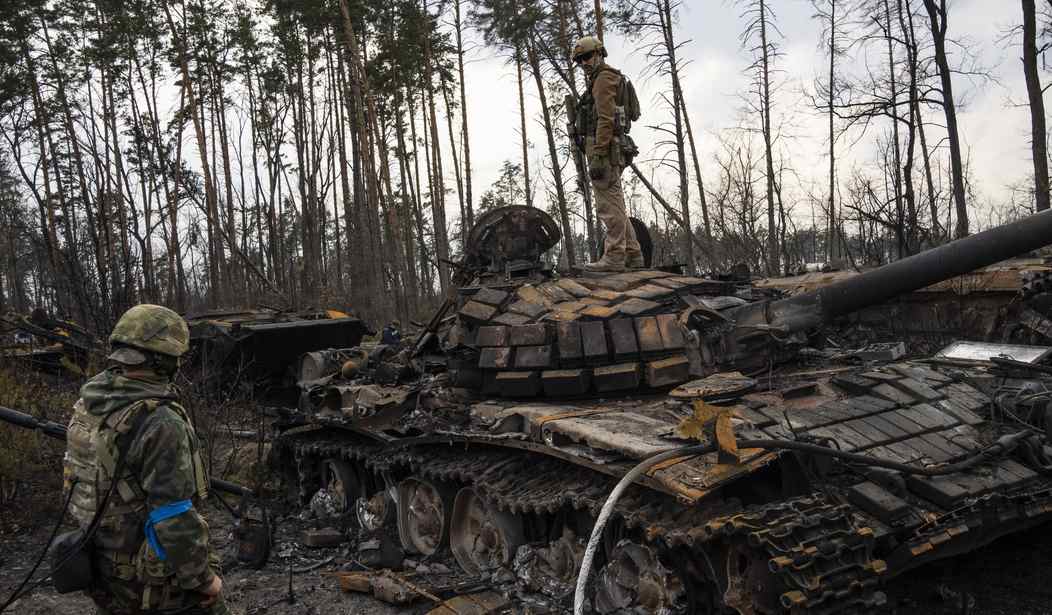If you’re like me, you’ve watched videos with near-glee of missile after missile destroying countless invading tanks in Ukraine.
Modern antitank missiles are so small and so fast and just so impressively destructive that it has some people wondering if the main battle tank — the military’s “arm of decision” since 1918 — isn’t finally obsolete.
Watching videos like this one, you won’t wonder why.
The American-made FGM-148 Javelin missile is a thing of deadly beauty. It’s a fire-and-forget system, meaning the shooter can skedaddle away from danger just as soon as he’s aimed and fired. For killing tanks, the Javelin flies above its target, then fires downward a two-stage shaped-charge warhead through the thin top armor. The first stage defeats any enemy countermeasures like reactive armor. The second stage blows up the enemy … real good.
It can hit and kill hard targets more than two miles away.
Even Ukraine’s less-sophisticated homegrown Stugna-P missile is scoring plenty of kills.
A few guys sneaking around the woods with a few antitank missiles can do a whole lot of damage to an entire armored column.
As of last week, open-source intelligence organization Oryx estimated that Russia had lost a total of 450 tanks, of which 221 were destroyed.
Russia’s plentiful (but older) T-72 tanks cost a couple million dollars to produce and modernize. A fully modern tank like their T-90 costs perhaps $4.5 million.
Each has a three-man crew, either killed, wounded, or at least traumatized by each lost tank.
The losses are up, and that has some experts arguing that the tank’s day is done.
Russia's war in Ukraine illustrates how warfare has changed. Tanks & armored personnel carriers have become obsolete. They are too expensive & are easily destroyed with manifold light anti-tank weapons or drones.
— Anders Åslund (@anders_aslund) March 18, 2022
But guess what: The tank isn’t dead. At least not yet.
RAND Corporation’s Scott Boston noted that Ukraine “would very much like to get support from the U.S. and from the West, with more armored vehicles and more tanks.” Kyiv wouldn’t be asking for more tanks if they thought they’d be death traps for their own forces.
So why is Russia losing so many tanks, so many crewmen?
The answer can be found in two things: Russia’s ongoing demographic collapse and the Russian military’s sad lack of training.
From the very beginning, more than a century ago during World War I, tanks were vulnerable to infantry attacks. While mobile and powerful, tank crews have limited visibility — and even the fastest tank is much slower than any antitank missile. In World War II, the German Army Group Center antitank manual put it bluntly: “Experience has shown that attacks against tanks with close combat weapons by a sufficiently determined man will basically always succeed.”
To be effective — and to not get blowed up real good — tanks must operate as part of a combined-arms team. Part of that team must be infantry, on the ground, keeping sharp eyes out for those other guys sneaking around the woods.
Footage from outside mariupol, please share, Russians not even supporting with infantry. Ambushed by javelin. pic.twitter.com/pQZOV69x0x
— Oleksiy Kovalenko (@slavaukraini97) April 7, 2022
What does any of this have to do with Russia’s demographic problems?
Lots of armored firepower but not enough trained infantrymen on the ground.
I have to get a little technical here.
For more than a hundred years, the combat division has been the main organizational unit of any large military. A division contains every kind of sub-unit required for sustained operations. Depending on the type, a division might range from 10,000 men to more than 15,000. Typically, lighter divisions like airborne or leg infantry are smaller than heavier ones like mechanized or armored.
But this is changing in Russia and even in the US.
“Beginning in 2010,” The National Interest breathlessly reported two years ago, “Russia’s ground forces began eliminating the division structure it had used since the battle of Stalingrad in favor of smaller, more lethal combined arms formations.”
Those smaller formations are known as Battalion Tactical Groups (BTG). A BTG usually consists of 600-900 men, heavy on armor and artillery, light on the support units necessary for sustained operations.
BTGs were first formed by the Soviets in Afghanistan, looking for combat units powerful enough to cause some serious hurt but small enough to react quickly to mujahideen attacks.
The Russian military came to rely on them during both Chechen Wars and the 2008 Russo-Georgian wars. Not because BTGs were necessarily more effective, but because Russia lacked the manpower to properly staff full divisions or even brigades.
Complicating things, most Russian foot soldiers are draftees who serve for only one year and do not receive the necessary training to serve as an effective part of a combined arms team.
That’s Russia’s demographic crisis made now, in Ukraine, into a potential military crisis.
BTGs were supposed to be the Russian army’s “tip of the spear.” But lacking the logistical support intrinsic to a larger divisional structure, and short on properly trained infantrymen, those BTGs have proven in large part to be sitting ducks to missile attacks.
From high-tech missiles to fairly simple drones, tanks have perhaps never been more vulnerable. The need for combined arms formations to be well-trained and well-trained together has perhaps never been higher.
But the enteral need for highly mobile, armored firepower still leaves a role for tanks, at least for the foreseeable future.
You’d just hate to have to serve in a Russian tank.










Join the conversation as a VIP Member